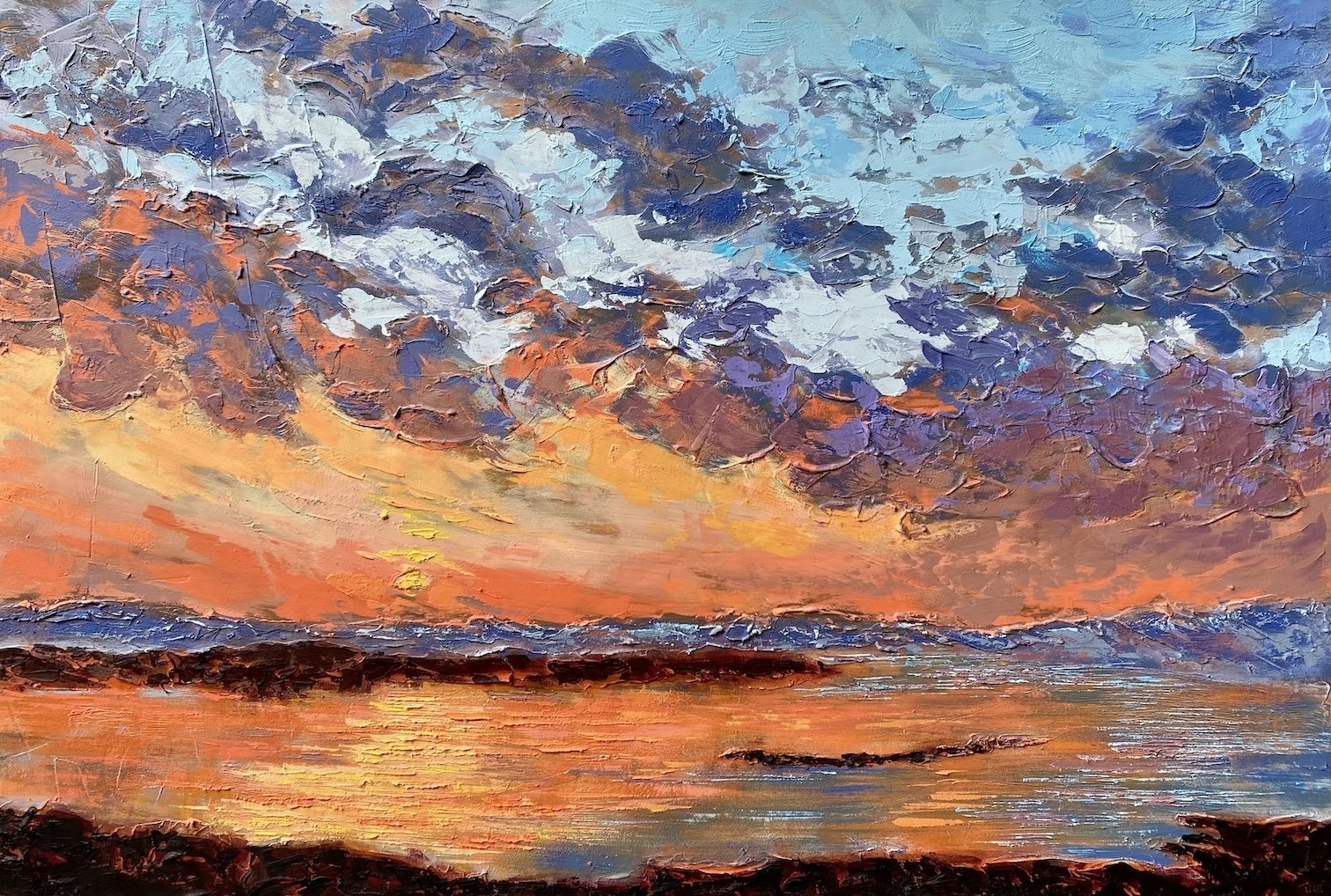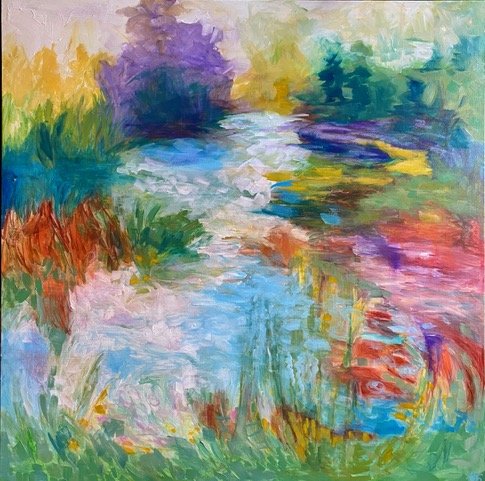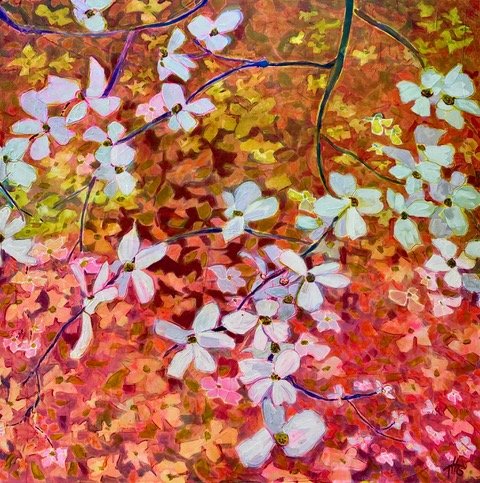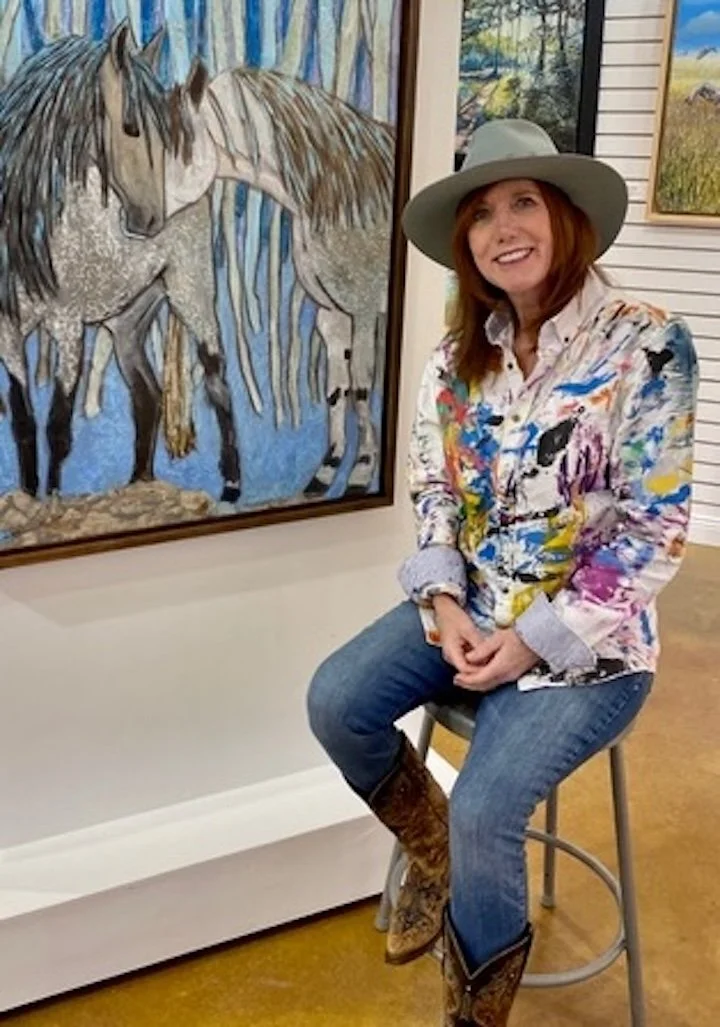Interview with artist Terri Haugen
Terri Haugen, originally from Michigan, is an Arkansas artist known for her extraordinary batik paintings, which have been featured on the covers of national magazines such as Yankee and Readers Digest. She has been featured on ABC's Home Show and HGTV, and has exhibited world-wide. More of Terri’s work can be found at Art Group Gallery in Little Rock an at her website terrihaugen.com.
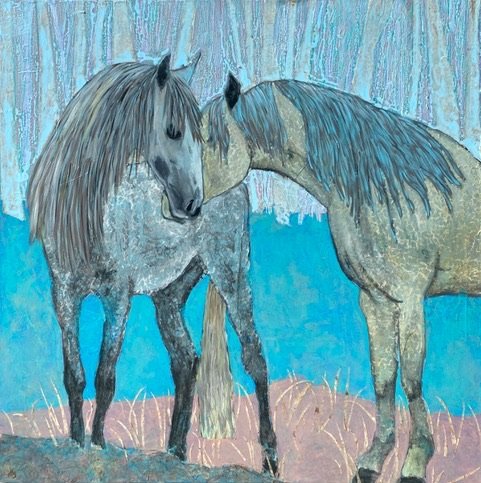
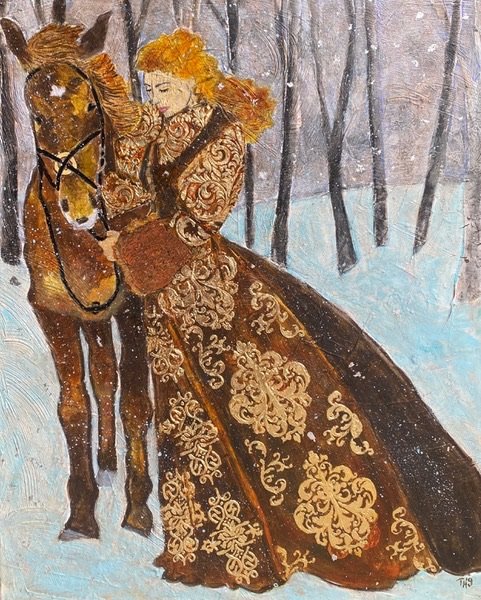



AAS: Terri, are you an Arkansas native?
TH: I’m a Michigan native, born in Hillsdale and grew up mostly in Northern Michigan (Traverse City). My first art sale was when I was 12. I started selling paintings and pottery at local art shows and art fairs regularly by the age of 16. When I was 18, I joined the Artist Market as a partner in Traverse City which was the main art gallery in the town. Back then I sold exclusively fine art batik paintings. I tried to go to college, but my work was selling so well I couldn’t keep up with both, so I went full time with my art. I moved part time to Arkansas about 16 years ago. The first six years I traveled every spring back to Frankfort, Michigan to open for the summer season my gallery, Les Sirenes Galiey D’Art. Frankfort is a resort town where most businesses are open only for the summer. My gallery was located on Main St. right on the bay that goes out to lake Michigan. It was about 10 years ago I became a full time Little Rock resident and around 8 years ago I became a partner in the Art Group Gallery at the Pleasant Ridge shopping Center. As a full time Arkansan, I began spending more time with traditional mediums like oil and mixed media. I had always wanted to do more traditional painting, during my time in Michigan, but I just didn’t have the extra time since batik is such a time-consuming medium.
AAS: Were you always interested in art and painting as a child?
TH: I’ve been an artist as long as I can remember. We have a lot of talent in my family. My aunt and uncle encouraged my artistic endeavors by supplying me with art supplies and a place to work. They both showed and sold their artwork locally. My grandmother was a ceramic and silkscreen artist and my mother painted and had a gallery. My father was an engineer and inventor. I was asked all the time when I was young what do you want to be when you grow up? I always said an artist.
AAS: You are internationally recognized for your batik paintings. Tell me about the batik painting process.
TH: I came to learn batik by accident really. In high school I was making jean vests for sale from old blue jeans. This one friend I did a vest for gave me a small book on batik in trade. I was totally enthralled. I had never seen this medium before. This is not something they teach in high school. I was taking an art class and our assignment was to do a painting using a water medium. I thought I’d be cleaver and do a batik to mess with my teacher, hoping to get a reaction out of him. Instead of him being mad he loved it and entered it into the talent show and it won first place, and he gave me an A for my semester grade. Not only that but he sold it. The reaction I was hoping to get from him I got from my mother instead! She was not too happy with me. I had torn up one of my bed sheets for the cotton fabric I needed and ruined her Iron when I used it to remove the wax. I also use the bathtub for dying and made a huge mess of it and everything around it.
Batik is a wax-resist process using hot wax painted on fabric using brushes and tools called tjanting for fine lines. Where the wax is applied those areas will remain the original color and resist the dye. The Indonesians are well known for their decorative fabrics. Though it is said that the Japanese used the art form as fine art called Rozome for kimonos and art panels for tea rooms long ago before anyone else. The art form is very old, practiced for centuries in many parts of the world including China, India, South America and Europe. Fragments of batiks have been found to be 2000 years old. The history of batik is very fascinating.
Most of my batiks I use a traditional method of over dying, removing the wax at times to achieve brilliant colors that cannot be over dyed. I start with a drawing on cotton or silk and apply hot wax to the areas I wish to be white. I then place the cloth in a dye tub using a procion dye of the lightest color of my painting. After a certain amount of dying time, I take it out and let it dry. I proceed to wax those areas that I want to stay that color and continue the process until I reach the darkest color. The colors mix as they lay over each other so that is why I start with the lightest color. For example, if I start with a light yellow and dye a light blue next I will get green and so on. Wherever the wax ruptures the dye will seep into those fine lines and create the crackle line. This can be controlled by how much bee’s wax compared to paraffin is used. My major works have up to 40 separate dye baths and waxing taking many weeks to complete. When finished I remove all the wax and mount the painting on acid free board and then frame it. My first batiks I stretched the painting like a canvas and surprisingly they look like they did when I first created them some 45 plus years ago.
AAS: I think Late August Pier is a wonderful example of your creative use of batik. Where is this scene from?
TH: This scene is from the Frankfort beach just down from my art gallery in Michigan. We have the most beautiful sunsets over Lake Michigan. This is one of my batiks from a series of summer sunsets, my goal was to have one for each day of summer. Every sunset is different depending on the weather. It is such a surprise and delight, nothing more wonderful than to watch the sun go down on the beach. Lake Michigan is like the ocean, you cannot see to the other side. The water is cool and the waves can be large but nothing in there will bite you. My children and I spent many summer days on the beach there. We would dress up with flowing dresses and umbrellas for photo shoots that I’d take home to my studio and paint. My early career in batiks featured my children, nature and wildlife. People that followed my work saw my children grow up in my paintings. Probably my most famous piece was Fetching The Cat. This scene was my daughter Monica holding a cat in front of an old house on Mackinac Island. That batik was chosen to be on the cover of Readers Digest and the International issue in 24 languages. I was told I was the first live artist to be featured, since they used to use only artists that had passed away. I was offered a New York City Gallery exhibit after that but I was too overwhelmed to take it on. I’m very sorry now that I let that go.
Late August Pier, 28” x 22”, batik
Fetching The Cat, 24” x 16”, batik
AAS: Crystal Downs Hole 17 is a joyous postimpressionism-style interpretation of what I’m sure was a lovely vista – but wow!
Crystal Downs Hole 17, 30” x 30”, batik
TH: I was commissioned to do some golf holes at the well-known golf course Crystal Downs Country Club. I ended up doing many pieces inspired by the course. At the time I didn’t know much about golf, it was just the sheer beauty of the area that inspired me so much. It wasn’t until I moved to Little Rock that I took up the game. The golf season is very short in Michigan and in Arkansas you can play year around. I’m totally hooked on the game now. It’s a good thing I didn’t play years ago, I would not have had the time to create so many paintings. I did a batik for the national cancer society titled The Miller Swing that raised money for cancer research. My father’s sir name was Miller and he died of lung cancer that year. I’ve created art for different venues such as Ducks Unlimited and Whitetails Unlimited. I worked and donated many pieces for charities in Michigan and was glad to do so.
AAS: You have lived and studied in Europe and exhibited around the world. What were those experiences like?
TH: I’ve been so lucky to be supported by my community and patrons. There were so many opportunities that came along. I had one couple that wanted to introduce me to the Paris art world. They were in the embassy and had connections in Paris. They found me an apartment to rent in Montmartre, close to where Van Gogh once lived. I met a lot of fun, crazy, and talented people that I will never forget. I was treated wonderfully by the French. Several artists that I met I invited to exhibit at my galleries. While I lived there, I studied with a sculptor. A couple of evenings a week I’d head to his studio where there were three other students. Our male model was an opera singer and during the break he would sing for us and hand out chocolates and champagne. I made one very special friend (Collette) and we spent hours at the museums and her country house outside Paris. We’d share our art techniques in her studio. On Tuesday nights we would go salsa dancing.
I loved it very much and thought of living there during the winter months when I was not so busy at home in the US, that didn’t work out. I had room to paint in my Paris apartment but not for doing batik. My batik work was selling well in the states, and I needed my specialized studio. I was really getting noticed by magazines for covers and stories. The Home Show came out to my studio for filming a segment with Gary Collins. HGTV did several shows with me. If I hadn’t had such a problem with stage fright I would have agreed to do more. I had other wonderful opportunities come my way that I did not take advantage of which now makes me sad. I was so lucky to be noticed being from a small town. I loved what I did and serendipity just happened.
Besides Paris and my exhibits in Japan and Belgium I took some time to go to Italy to learn mosaic. That was a wonderful time, and I was introduced to a famous glass maker in Venice. I was able to bring home some wonderful handmade glass to work with. I haven’t used that special glass yet, but I did do the entryway into my art gallery.
AAS: You also do mixed media work. Tell me about Being Vogue and that wonderful background.
Being Vogue, 30” x 24”, mixed media
TH: I love old ephemera and I have a bunch of old magazines from the 20’s and 30’s. I love the fashion from those times. I drew inspiration from some of the old photos in the magazines and did my own thing with them. Being Vogue has been in my studio for the last four years going through different stages. Sometimes something doesn’t look right so you set it aside. Sometimes you don’t know where to go with something either. Both of those were the case with her. This last winter she finally started to come around. I cut some stencils and created a textured background. I used some other techniques to create texture and interest. I added some gold foil and she finally said enough, you are done!
AAS: I want to ask you next about your oil and cold wax paintings. Around the Lake is a very dramatic painting and I love the way you painted the sky – I can hear the winds. Tell me about that painting and the technique you used.
TH: I grew up with my family having a small cottage on Bellows Lake in northern Michigan. We spent the summers canoeing, fishing and calling the Loons. This painting is one of my fond memories of summers on the lake. I added a cold wax medium to my oil paint to give it thickness. It’s too heavy to use a brush so I mostly used a pallet knife. Cold wax medium also helps the oil paint dry fast.
Around the Lake, 12” x 24”, oil and cold wax
AAS: Maybe my favorite of all is Little Rock. Your interpretation is something I have not seen before.
Little Rock, 36” x 36”, mixed media
TH: This was my first experimental piece of art using a wood burning tool and oil/cold wax. I first drew an abstracted view of the Little Rock scene and burnt into the panel those outlines. I then covered the panel with black gesso. Instead of using a pallet knife to apply the paint I rolled the oil and cold wax on with a brayer in layers. I really had fun with this piece and can’t wait to try another.
AAS: You also paint wonderful abstracts. The Birds Are Happy is terrific. It is in yet another style and technique.
The Birds Are Happy Today, 32” x 48”, mixed media
TH: Every so often I get out of my norm and do a little shift. I took a big canvas outside on a cool but beautiful morning and laid it on the ground in the garden. Without thinking too much I took some water-soluble crayons and started making marks. I then used acrylic paint and more layers of the crayons. It really is amazing to me when I just do something without a plan and something happy turns out so easily. I wish I would do that more often. It’s like you get into a different world and don’t even remember afterwards how exactly you did that. The birds that day were really singing and having a wonderful time.
AAS: I won’t ask you which is your favorite medium, although I assume it is batik, but do the different media or techniques you use bring out different artistic expressions?
TH: I put a lot of years into exploring batik medium. I really loved the look of it, it was different and there was not too many artists using that medium for fine art. I was hoping to become the best there was and raise the craft of batik to the fine art. I ran into some major show jurors that didn’t know what batik was and thought it was tie dye. I did finally get my batiks into the fine art category and into several museum shows. But it took a while and there were many rejections at first. If those first batiks hadn’t gotten so much attention, I may have moved on to something else. Before I did my first batik I did watercolors, pottery, weaving and clothes design. I loved so many different art forms, but I remember my art teacher telling me I need to stick to one and be the best at it. I’ve always wondered what would have happened if I had gone to college and studied in Europe first before opening galleries and working. Would I had been a painter? Probably not a painter using the batik medium. I have felt regret in the past that I didn’t obtain a college degree, but things still worked out well for me.
AAS: Terri, what can we expect next for you?
TH: I’m working on an exhibit called Hot Wax/Cold Wax. It will be a selection of my batiks and similarly inspired paintings using oil and cold wax medium. They will be mostly landscapes and skyscapes of northern Michigan and Arkansas.
I have a joint project with my youngest daughter, Kindra Haugen. We started Trick Fish Publishing and we have our first children’s book coming out in the next couple of weeks. She grew up in my studio and I knew she was an artist at age two. HGTV did a show on her featuring her painted rocks when she was five. She was accepted to Interlochen Arts Academy and went off to Ringling College of Art and Design.
I wrote As Forest Angels Gather, back when Kindra was two years old to go with the batik. I had a publisher at the time, and I was to complete the illustrations in batik but life got in the way. Thirty something years later Kindra has redone all the illustrations with her digital paintings. I have written two other books one I’m illustrating Good Night Fox and one other Kindra will do Captain Cosmo’s Dreamship.
Now that I’m not solely doing batik there are so many paintings I can’t wait to do. I’m exploring the different mediums and having so much fun. I wish there were more hours in the day so I could get everything painted that needs to be. I’m working on new paintings for The Art Group Gallery and can’t wait to go on my next painting adventure.
